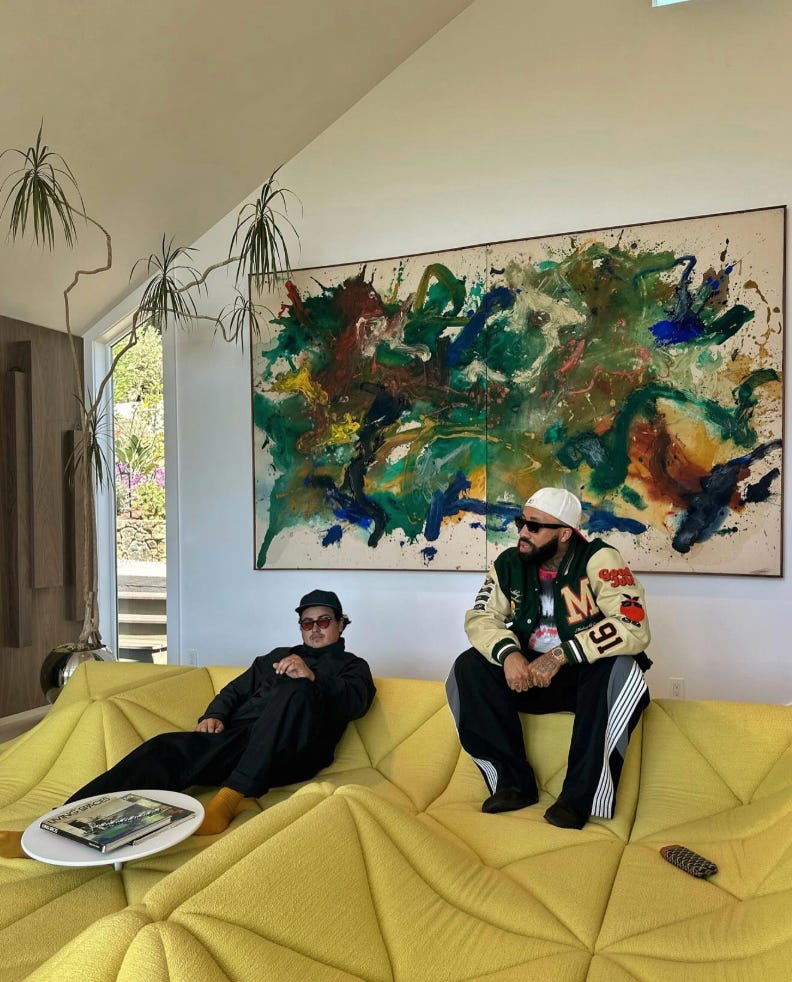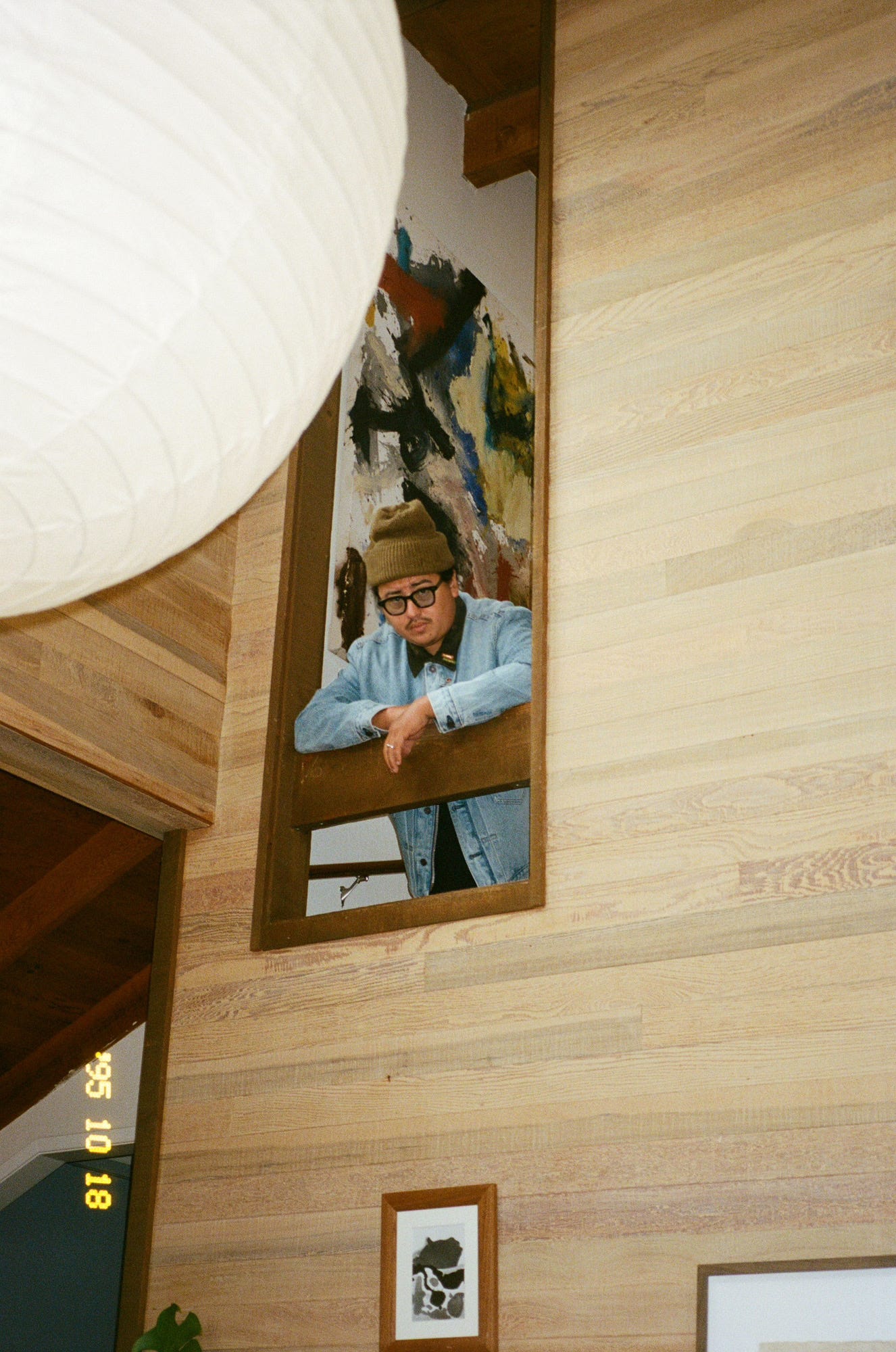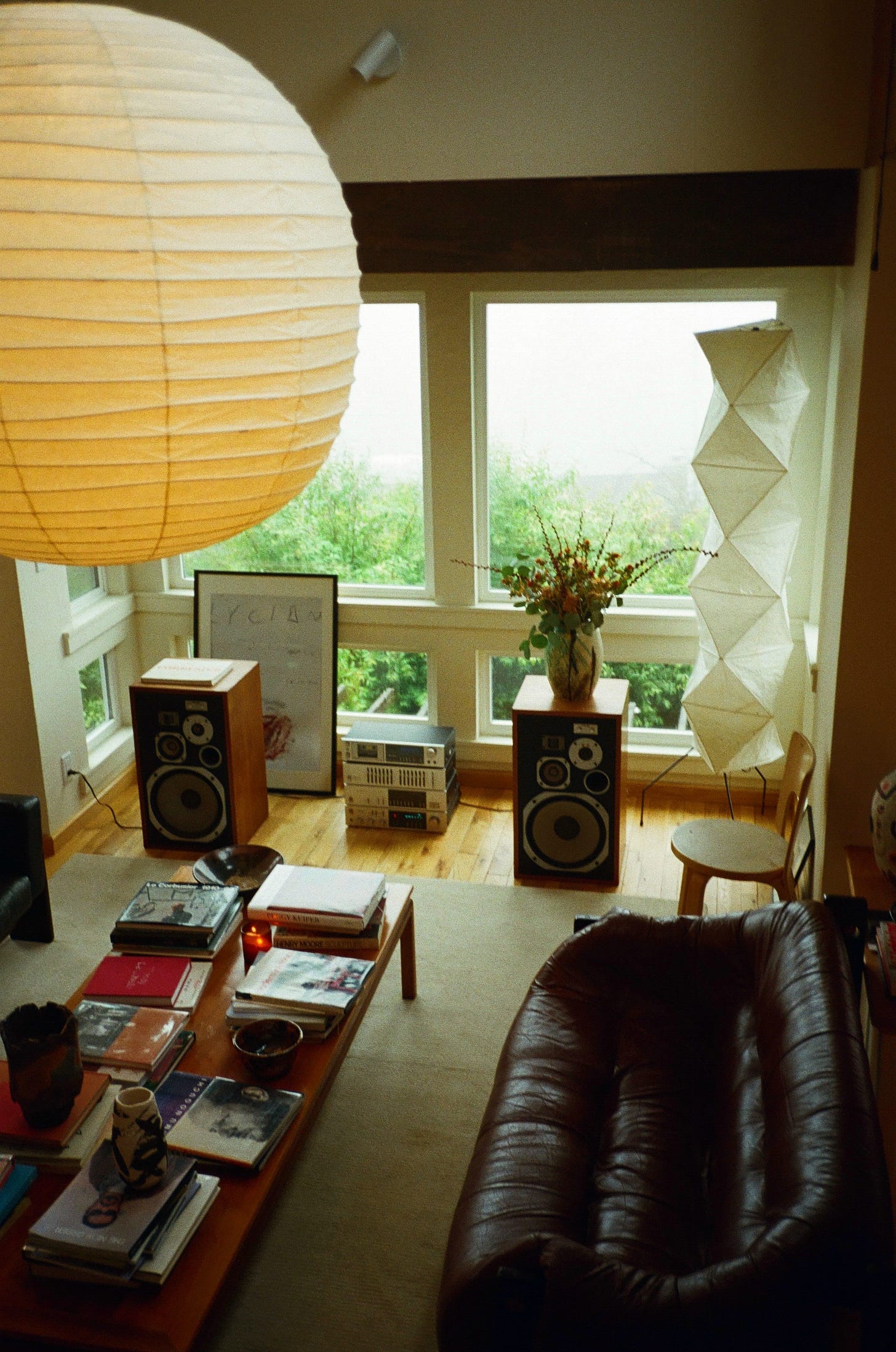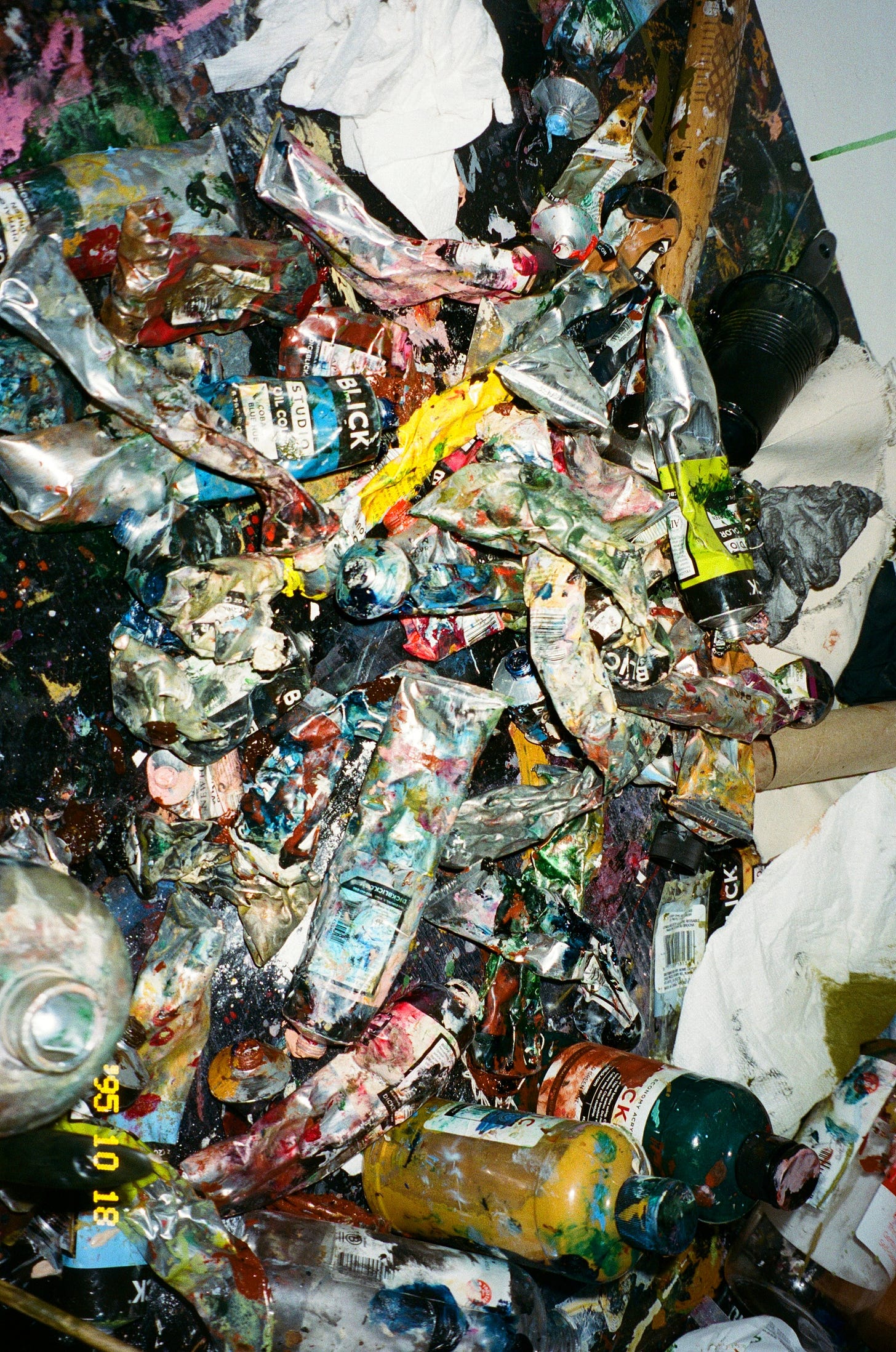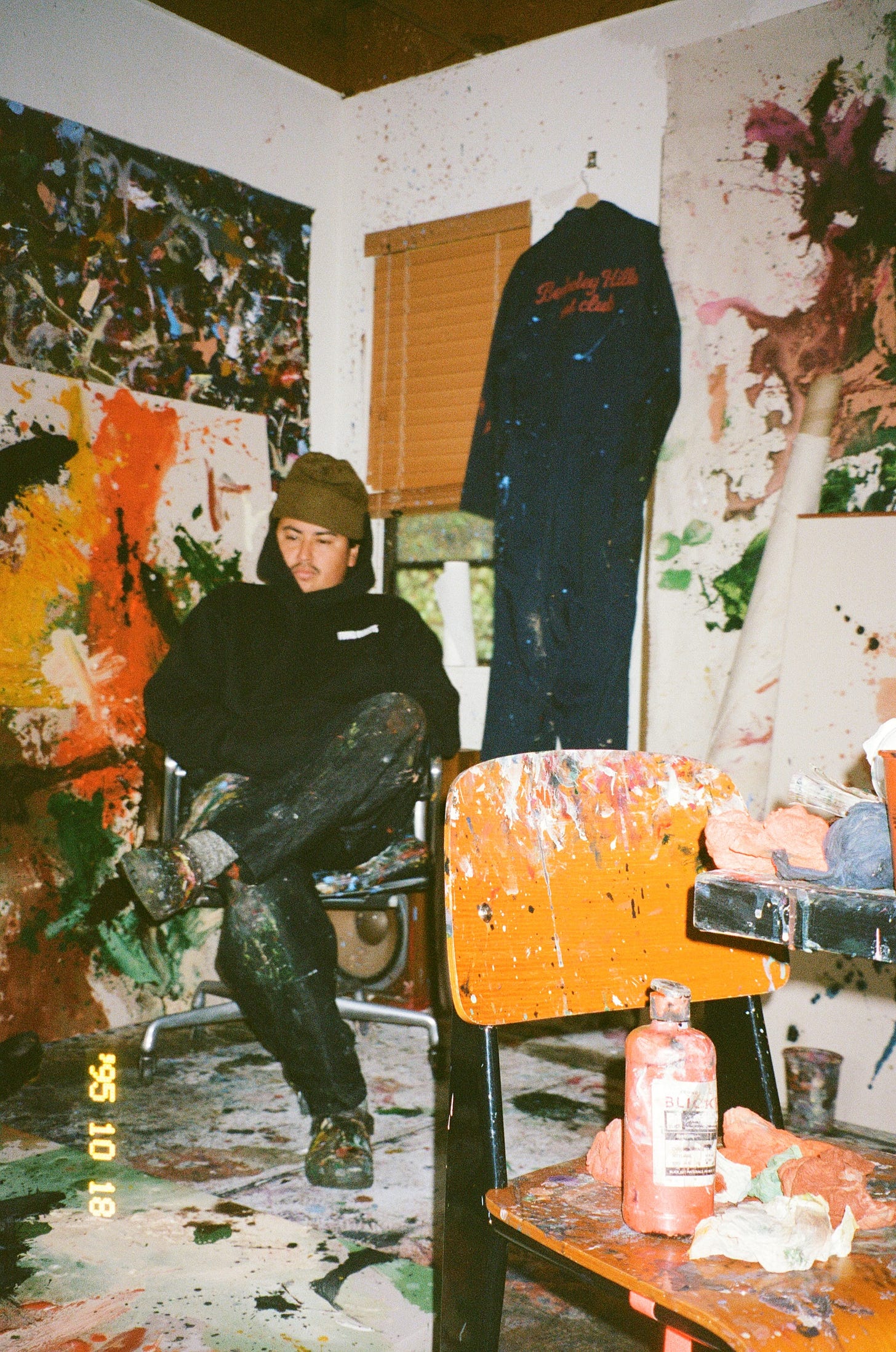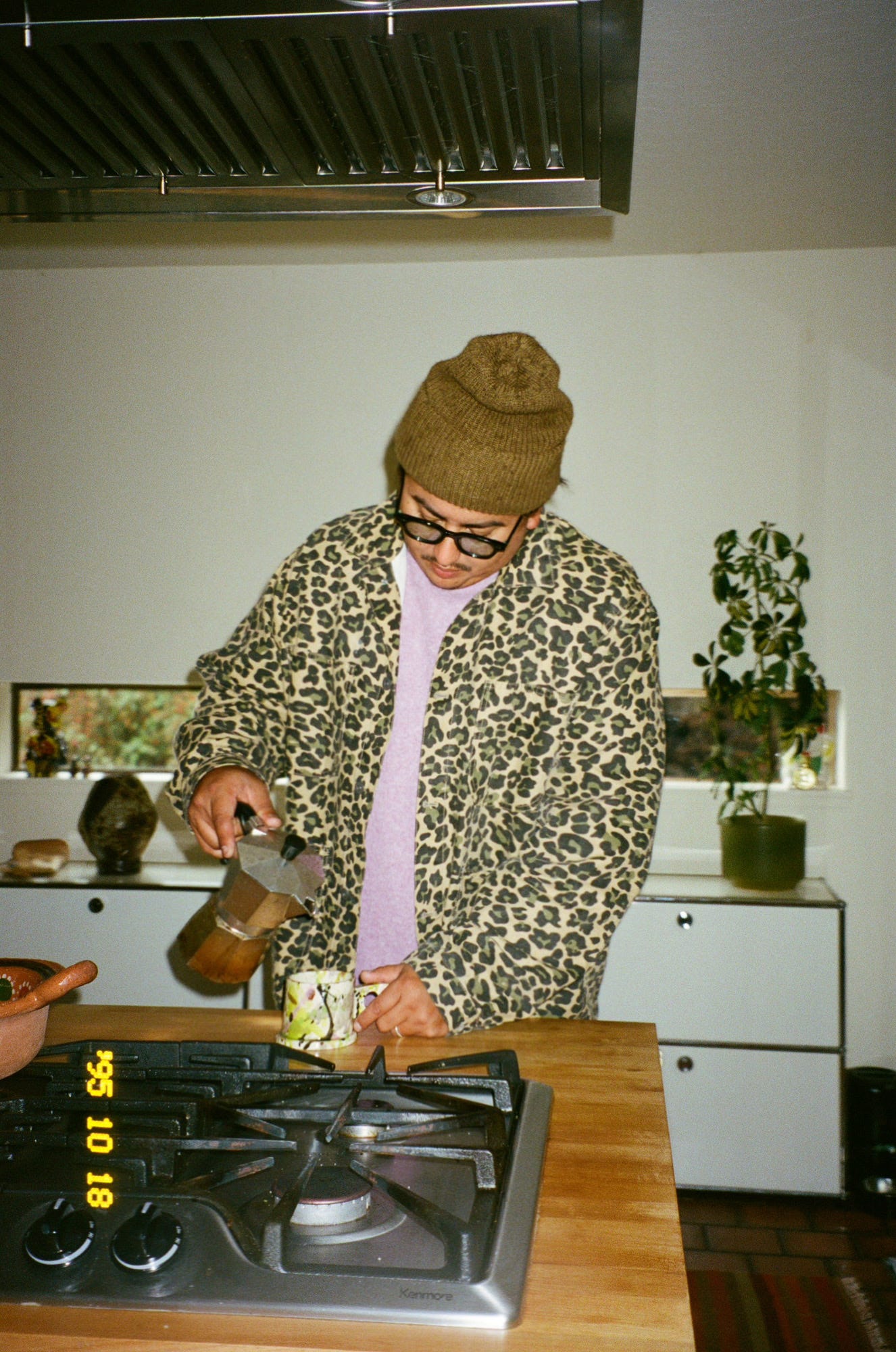Making art with Jereme Mendez
Inside the artist’s ongoing journey with mental health, creative rebirth, and finding clarity in the canvas.
In the five years we’ve been writing this newsletter, we’ve met some incredibly interesting and talented people.
I’ve always wanted Sprezza to feel like a place where you could take stylistic inspiration from those who are simply living their lives, because I think that’s where the best taste comes from.
This summer in Paris, we met Jereme Brian Mendez (aka JB) at a Beams party, and the rest is history.
He’s an incredibly talented designer and artist who we recently sat down with and had the chance to tell his story.
Maybe you’ve seen his artwork floating around the World Wide Web or spotted him posting up with the Larry June on his Pierre Paulin dune sofa in front of a massive double-panel piece he commissioned JB to paint.
But Mendez’s best work is coming in early 2026. “I just filmed a short documentary,” he tells me. The title is Eternal Spring. “The main idea centers on me explaining what I feel I’m going to be like as a dad, and the experiences that have led me here,” he says.
As he awaits the birth of his first child next year, he feels everything in his life has prepared him for this moment.
He keeps it all in perspective: “You do all these amazing things, but you’re a dad first and foremost.”
For a guy becoming more recognized in the art space each day, it’s been an uphill battle, to say the least. From being an in-demand furniture dealer to navigating anxiety and depression (and even partially losing his vision from stress) he found solace in the canvas.
His abstract work is moody, and, as he puts it, “I think what I put out is this controlled chaos.” According to Mendez, people want spaces that feel calm and peaceful, but they also need balance. “That’s where my abstract work comes in.”
When you see his pieces, there’s an energy, one that’s not overbearing. “It just clicks. It’s like the missing puzzle piece,” he says.
Our conversation with JB felt almost like a therapy session as he opened up about his mental health, how the title of one of his early pieces symbolized and cemented his career as an artist, the importance of taste, and what he hopes the recipients of his artwork feel.
Without further ado, here’s our sit-down.
PS - huge shouts to JB’s friend, Marco Verdiin, for all these wonderful film shots!
Can you share a bit about your background? How long have you been painting, and what first drew you to it?
I’d been painting for about seven years, but it only became professional in the last four, and truly took off in the last two. Before that, painting lived alongside the furniture work my wife and I did.
We ran a hidden showroom out of our Oakland loft (20 minutes from Berkeley, but a completely different world. The graffiti, the grit, the raw energy) it all seeped into what we built.
The showroom was our home and our hub. No advertising, just word of mouth. People came for the furniture but stayed for the experience… espresso, champagne, conversation, community.
We became a destination. We even hosted a Harvard Architecture event that brought students together with local artists, chefs, and graffiti writers. It was special.
After three years of that success, I suddenly hit a wall and had anxiety and depression out of nowhere. Everything I loved felt erased except my love for my wife. I stopped the showroom completely. Looking back, it was years of unprocessed life catching up with me.
About eight months in, my wife was supporting us. I tried getting a job just to be around people and ended up at Trader Joe’s. Around the same time, I started losing my vision with flashes, blurs, tests, then the diagnosis: I was going blind.
My options were a risky surgery or experimental monthly eye injections. I chose the shots, which left me nearly blind for a day or two after each treatment.
Ironically, that’s when painting returned. Color and flowers were the only things that sparked anything in me. I began painting small pieces before work, then larger ones. One abstract piece went viral.
On what became my last day at Trader Joe’s, I accidentally severed my thumb. In the ER, the doctor saw one of my floral paintings and said, “What the fuck are you doing working at Trader Joe’s when you paint like that?” It felt like the universe speaking.
Days later, a former neighbor with luxury boutiques asked me to show work in her new store. She wanted six pieces in a week for their art walk.
We had no money, maxed a card for supplies, and I painted with my thumb wrapped like a cartoon character. Everything from that dark year poured out of me.
The show was packed; had hundreds of people. My main piece, There’s No Turning Back, was the star. By the end of the month, everything was sold. That’s when I knew: I’m an artist.
Since then, my work has traveled farther than I could’ve imagined, from athletes buying my work to painting a double panel for Larry June. I’m just grateful.
My mission now is simple: keep going and support my family. There’s no turning back.
How would you describe your painting style, and how did you come to find it?
I like to align my paintings in a way that connects with the human senses. We smell, we hear, we touch.
When I look at my work, I sometimes feel this sense of freshness. Especially living here in Berkeley, up in the hills, there’s this green, almost “crunchy” feeling to it.
Most importantly, there’s a choreography to it, especially in my pure abstract pieces. I have such a connection to the canvas that it lets me tap in and go into a kind of trance.
The moment I’m in the studio, the door closes, and the music comes on, I’m locked in. It becomes a full station for me, and that choreography becomes this pure waltz.
People laugh, but I feel like I have to romance the canvas before I go from brush to surface, because the outcome is either going to be good or it’s going to be bad.
It’s all mindset for me. In that choreography (that dance) I can tell right off the bat, from the moment I touch brush to canvas, whether it’s going to be a good one. It’s cool.
Color plays such a strong role in your work—how do you approach it? Do you find yourself drawn to different tones depending on your mood or the season?
Yeah, definitely. I think having an appreciation for design, and having dabbled in menswear early on, I’ve adapted that sensibility into my work. In Spring/Summer, I lean into more vibrant tones, still moody, but with a bit more lift.
Once we roll into October and move toward winter, it shifts into deeper tones: maroons, browns, creams.
My style in general is very moody, and I think that ties into the Pisces side of me, being a water sign. I’m a lover of romance, a lover of all things moody and intelligent. So I think that drives the connection people feel when they encounter my work.
They can’t always explain it (visually they love it, obviously) but 9/10, when a piece leaves my studio, the client tells me, “I can’t explain why I love this, but there’s just this pure connection.”
That really means a lot to me. Emerging from depression and such a dark time, I didn’t want people to look at my work and think, Man, this guy is going through it. He might be really down. Instead, I can confidently say there’s a real beauty and positive connection people feel with it. And that’s incredibly important to me.
Your home feels like a Tumblr mood board brought to life. How did you develop your taste and sense of aesthetic?
It really comes down to personal taste. The pieces I’ve collected over the years reflect my life as an artist. I’ve always wanted a home that feels lived in by a creative.
With a background in furniture sales and showroom management, creating a cohesive space has always mattered.
Acquiring this house felt almost spiritual. Growing up, you could see the Berkeley Hills from Oakland, a place rich with architects and creatives. Inspired by the 1892 Hillside Club, I made my own playful version: the Berkeley Hills Art Club.
When we finally got this home, I cleared out everything and started fresh, bringing in period-correct pieces for the 1972 Third Bay–style design, which balances sleek, angular exteriors with warm, inviting interiors.
Our priorities were simple: a room for our future child, our bedroom, and a studio where I could fully live the artist life. That lifestyle, from how I dress, work, and live authentically, is everything to me.
I wake up every day grateful for the view, the furniture, and the fact that we earned it all.
I also have a knack for hunting furniture deals. That Percival Lafer sofa? Worth $7–8k, but I sniped it for way less. When I see a piece, I go for it.
Music, design, clothes, and art all seem to live in the same ecosystem for you. How do you maintain that through line across what you do?
Yeah, you know, it goes back to lifestyle. I think I’ve only followed one trend in my entire life, and my wife always laughs at me about it. It was early on, during that Fear of God era, and I busted out the Chelsea boots, the ripped jeans, the long-ass T-shirts… the whole thing.
One day, I looked in the mirror and was like, Dude, I look like a clown. It just wasn’t me.
It worked for other people, and I think that’s why I was drawn to it. But the moment I had that realization of “Yo, this isn’t you, Jay”, and I went straight back to skate culture. I grew up skateboarding, so I wore a lot of baggy clothes.
I’m also a ’90s baby, so that baggy stuff has always been a part of me.
Even now as an adult, I have this sort of “uniform,” and I make sure it fits the same vibe as my home and studio, very relaxed. I naturally gravitate toward baggier trousers or oversized jackets. I’m a pretty tall guy with broad shoulders, so that oversized look just works for my frame.
But yeah, after that one trend-following moment, I never did it again. People might say skateboarding style is a trend too, but to me it’s not about that. It’s about following your own uniform and what actually works for you. And honestly, I just like the simplicity of things.
What’s your go-to outfit when you’re painting—something you can really get in the zone in?
My go-to outfit recently has been Stüssy, and I’m a huge fan of the big ol’ jean. It’s just the perfect fit. I don’t know, man—Stüssy hasn’t missed for me in a long time.
They’ve done such a great job, you know? A lot of people know Stüssy started early on, but they’ve really stayed true to themselves. They don’t follow trends, they’ve just stayed consistent with the vibe they started with.
When you’re commissioned for a piece, what’s an intangible thing you hope the recipient feels or takes away from it?
Yeah, I think it goes back to the response I regularly get: people just feel connected to the work. And, man, with the large-scale pieces I do—because I’m definitely known for the bigger stuff—people often choose the most important spaces in their homes to hang it.
I’m always like, “You really want to eat dinner in front of that every day? You want that above your bed or in your living room?”
But I think what I put out is this controlled chaos. You know, nowadays (and honestly even years ago) people want spaces that feel calm and peaceful, but they also need balance. That’s where my abstract work comes in.
It becomes this happy medium for people who gravitate toward serene spaces but still want something with energy. When they see my pieces, it doesn’t feel overwhelming; it doesn’t feel like “too much.” It just clicks. It’s like the missing puzzle piece.
So, like I said, longevity means a lot to me. I hope these pieces carry on over the years, and even if someone moves to a new home, the work still fits.
And, yeah, that spiritual connection people have to my art. So I want that to continue.
It’s never really been about the financial side for me.
I mean, sure, it helps me and my family live, but the real hit of gratitude comes when I see someone tear up in front of my work. It’s insane… but I’m into it.


